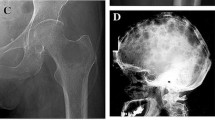Abstract
Gorham's disease may develop in any region of the skeleton, but shows a predilection for the bones of the shoulders and pelvic girdles. Less frequently, the disease may involve the spine, and it is the proximity to the spinal cord which may worsen the patient's outcome. We report the clinical outcomes of two children with typical, yet differently localized involvement, and also review the plain film, CT and MRI findings
Similar content being viewed by others
References
Gorham L, Stout A (1955) Massive osteolysis (acute spontaneous absorption of bone, phantom bone, disappearing bone): its relation to hemangiomatosis. J Bone Joint Surg [Am] 37: 985–1004
Abrahams J, Ganick D, Gilbert E, Wolfson J (1980) Massive osteolysis in an infant. AJR 135: 1084–1086
Torg JS, DiGeorge AM, Kirkpatrick JA Jr, Trujillo MM (1969) Hereditary multicentric osteolysis with recessive transmission: a new syndrome. J Pediatr 75: 243–252
MacPherson RL, Walker RD, Kowall MH (1973) Essential osteolysis with nephropathy. J Can Assoc Radiol 24: 98–103
Patrick JH (1984) Massive osteolysis complicated by chylothorax successfully treated by pleurodesis. J Bone Joint Surg [Br] 66: 148–149
Hardegger F, Simpson LA, Segmueller G (1985) The syndrome of idiopathic osteolysis. J Bone Joint Surg [Br] 67: 89–93
Heyden G, Kindblom LG, Nielsen JM (1977) Disappearing bone disease. A clinical and histological study. J Bone Joint Surg [Am] 59: 57–61
Johnson P, McClure J (1958) Observations on massive osteolysis. Radiology 71: 28–41
Sage MR, Allen PW (1974) Massive osteolysis: report of a case. J Bone Joint [Br] 56: 130–134
Hejgaard N, Olsen PR (1987) Massive Gorham osteolysis of the right hemipelvis complicated by chylothorax: report of a case in a 9-year-old boy successfully treated by pleurodesis. J Pediatr Orthop 7: 96–99
Bullough P (1971) Massive osteolysis. N Y State J Med 71: 2267–2278
Siegel MJ, Glazer HS, St Amout TE, Rosenthal DD (1989) Lymphangiomas in children: MR imaging. Radiology 170: 467–570
Bullough P (1971) Massive osteolysis. NY State J Med 71: 2267–2278
King DJ (1946) A case, resembling hemangiomatosis of the lower extremity. J Bone Joint Surg 28: 623–628
Joseph J, Bartal E (1987) Disappearing bone disease: a case report and review of the literature. J Pediatr Orthop 7: 584–588
Author information
Authors and Affiliations
Rights and permissions
About this article
Cite this article
Dominguez, R., Washowich, T.L. Gorham's disease or vanishing bone disease: Plain film, CT, and MRI findings of two cases. Pediatr Radiol 24, 316–318 (1994). https://doi.org/10.1007/BF02012113
Received:
Accepted:
Issue Date:
DOI: https://doi.org/10.1007/BF02012113




